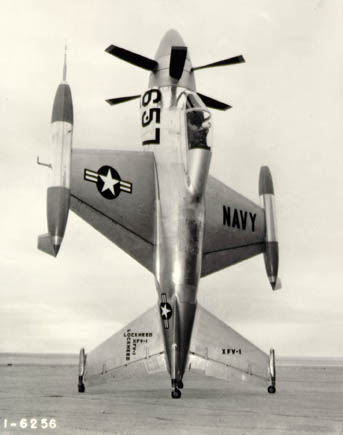All We Have To Do To Fix The Planes / Schools Is Put The Best Pilots / Teachers In The Worst Situations
By Steve Sailer
12/22/2013
|
Lockheed XFV Salmon, 1954 |
It’s a truism of the Education Reform movement that all we have to do to fix the schools is to put the best teachers in front of the worst students. Unfortunately, due to white racism and white privilege or something, the best teachers somehow keep getting assigned to the schools with the best students.
The Pentagon has often been tempted to think analogously — all we have to do to make our worst aircraft actually work is to put our best pilots in them.
Consider the example of Lockheed’s 1950s vertical take off and landing fighter, the XFV, which could theoretically convert any warship into an aircraft carrier.
|
McDonnell XF-85 Goblin parasite fighter, 1948 |
Or McDonnell’s 1940s "parasite" mini-fighter, which was designed to be carried in the bomb bays of the slow B-36 nuclear bomber and then released over the Soviet Union to do battle with Red interceptor jets. The B-36 was an early Cold War heavy bomber with immense range and capacity useful in dropping nuclear bombs on sites deep within the Soviet Union. But even in a streamlined version with all the defensive guns removed and four jet engines added to the six propeller engines, it was a sitting duck for Soviet jet interceptors.
|
YRF-84F launching from B-36 |
No American fighters had the range to accompany the B-36, so the Air Force came up with the bright idea of the "parasite fighter," which would hitch a ride with the B-36 until it was time to fight. The Pentagon commissioned the XF-85 mini-fighters that could fit inside the B-36 until it’s time for a dogfight. Won’t Ivan be surprised when a tiny fighter jet pops out of the big fat prey!
The Air Force also tried hauling an F-84 fighter-bomber externally under the B-36 to provide protection and/or fly ahead to drop a nuclear bomb whose shockwave the B-36 would be too slow to get away from.
All these concepts had similar fundamental problems: Taking off was a challenge that could likely be managed, but landing / reattaching a short range fighter in a vast hostile expanse (the ocean or Soviet airspace) was both essential and extremely tricky.
A successful modern VTOL like the British Harriers comes back down where it took off by diverting its jet blast downward so the pilot is facing forward and can see the surface below him. But Lockheed wasn’t close to that technology in the 1950s, so it proposed landing rather like parallel parking a car: the pilot’s seat faced straight up into the sky, so the pilot just had to look over his shoulder a lot and carefully gauge how high he was off the deck. Test pilots spent some time trying to back down onto clouds for practice, but found the prospect of landing backwards on a deck rolling up and down on the waves to be daunting.
Similarly, the various attempts to mate the B-36 back up with their parasite fighters proved very, very hard. Outstanding fighter pilots could sort of pull it off in smooth weather.
So, one solution to these problems would be to take the Navy and Air Force’s absolute best pilots and assign them to these daunting challenges. But the problem with that was that all these concept fighters were slower than the enemy’s conventional fighters they were supposed to dogfight with, so the attrition rate among America’s best pilots would have been horrific, both in combat and accidents.
But even that assumes you could get the best pilots to volunteer to fly underpowered death traps.
You can get many of them to volunteer in peacetime to be test pilots and risk their lives over Edwards AFB or Area 51 in the latest brainstorms.
But the best pilots prefer to go to war flying the best all-around planes. In the movie Top Gun, for example, Tom Cruise flies an F-14 Tomcat, a highly successful Navy fighter with a high chance of shooting down the enemy relative to the F-14’s chance of being shot down or crashing due to the difficulty of flying it. The Top Gun school was built on the premise of giving the most promising pupils the best teachers and assistance, which is how basically all successful educational institutions in history have operated from the days when Socrates taught Plato and Plato taught Aristotle.
The analogy to the basic assumptions of educational reform — all we have to do is make the best teachers teach the worst students — seems pretty obvious. The Pentagon could have ordered its best pilots to fly the Salmon and the Goblin in combat, but it would soon have started to run out of its best pilots.


